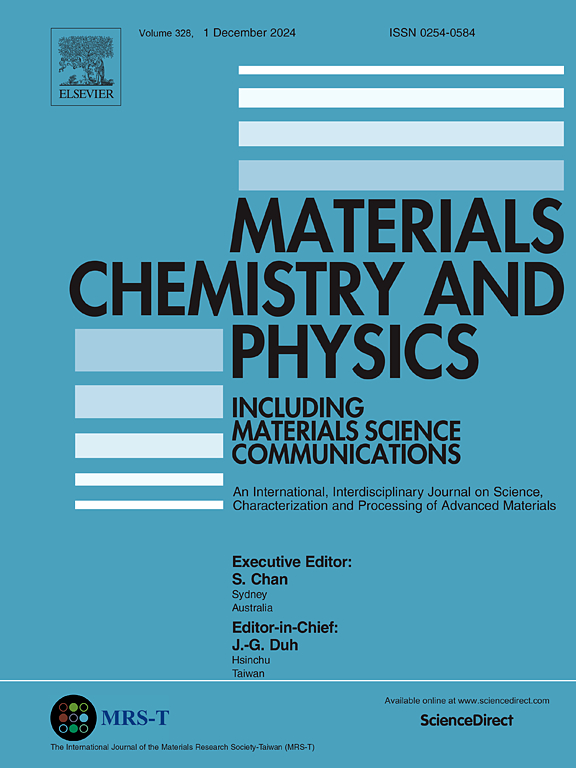Chitosan@MnO2-perlite复合材料吸附去除水中的Cr(VI)
IF 4.3
3区 材料科学
Q2 MATERIALS SCIENCE, MULTIDISCIPLINARY
引用次数: 0
摘要
本文研究了六价铬(Cr(VI))在策略设计Cs@MnO2-perlite复合材料上的吸附。表征证实了复合材料的坚固结构和高比表面积,有助于其优越的吸附性能。综合动力学,等温和热力学模拟研究进行调节,以了解吸附行为和效率。吸附动力学遵循伪一阶模型,表明吸附速率与复合材料上可用活性位点的数量成正比。等温分析表明,吸附数据符合Langmuir模型(R2 = 0.99),表明在60℃时,单层吸附Cr(VI)的最大单层吸附量为281.7 mg/g。热力学参数表明,吸附过程是熵驱动的、自发的、吸热的,表明固液界面的随机性增加,吸附需要热输入。再生研究表明,该复合材料具有可重复使用性和长期稳定性,即使在连续5次循环后,Cr(VI)的去除效率也降低了5%,这凸显了其具有成本效益和可持续环境应用的潜力。通过DFT计算和蒙特卡罗模拟研究了Cs@MnO2-perlite上Cr(VI)的去除效率。结果表明Cs@MnO2-perlite和Cr(VI)离子的所有组分之间存在很强的相互作用。这些发现突出了Cs@MnO2-perlite复合材料作为一种从水溶液中去除Cr(VI)的有效吸附剂的潜力,对环境修复工作具有重要意义。本文章由计算机程序翻译,如有差异,请以英文原文为准。
Chitosan@MnO2-perlite composite for the adsorptive removal of Cr(VI) from water
Herein, hexavalent chromium (Cr(VI)) adsorption was explored on strategically designed Cs@MnO2-perlite composite. Characterization confirmed composite's robust structure and high specific surface area, contributing to its superior adsorption performance. Comprehensive kinetic, isothermal, and thermodynamic modelling studies were regulated to understand the adsorption behavior and efficiency. Adsorption kinetics followed a pseudo-first-order model, indicating that the rate of adsorption was proportional to the number of active sites available on the composite. Isothermal analysis showed that the adsorption data was fitted to Langmuir model (R2 = 0.99), suggesting monolayer Cr(VI) adsorption with a maximum monolayer adsorption capacity of 281.7 mg/g at 60 °C. Thermodynamic parameters revealed that the adsorption process was entropy-driven, spontaneous, and endothermic, indicating increased randomness at the solid-solution interface and the necessity of heat input for adsorption. Regeneration studies demonstrated the composite's reusability and long-term stability, showing a minimal 5 % reduction in Cr(VI) removal efficiency even after five consecutive cycles, highlighting its potential for cost-effective and sustainable environmental applications. The removal efficiency of Cr(VI) on Cs@MnO2-perlite was also investigated through DFT calculations and Monte Carlo simulations. Results showed strong interactions between all components of the Cs@MnO2-perlite and Cr(VI) ions. These findings highlight the potential of Cs@MnO2-perlite composite as an effective adsorbent for Cr(VI) removal from aqueous solutions, with significant implications for environmental remediation efforts.
求助全文
通过发布文献求助,成功后即可免费获取论文全文。
去求助
来源期刊

Materials Chemistry and Physics
工程技术-材料科学:综合
CiteScore
8.70
自引率
4.30%
发文量
1515
审稿时长
69 days
期刊介绍:
Materials Chemistry and Physics is devoted to short communications, full-length research papers and feature articles on interrelationships among structure, properties, processing and performance of materials. The Editors welcome manuscripts on thin films, surface and interface science, materials degradation and reliability, metallurgy, semiconductors and optoelectronic materials, fine ceramics, magnetics, superconductors, specialty polymers, nano-materials and composite materials.
 求助内容:
求助内容: 应助结果提醒方式:
应助结果提醒方式:


